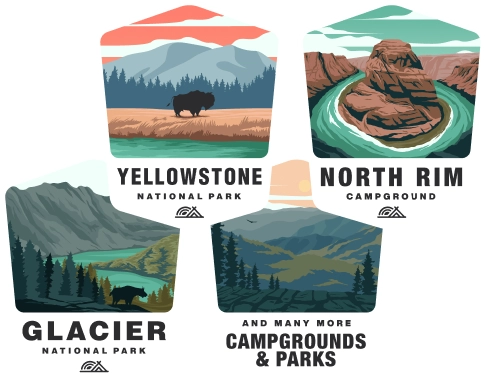Camping at Bitterroot National Forest
Location and Overview
Bitterroot National Forest is located in the United States, predominantly in west-central Montana, with a small section in Idaho. Covering approximately 1.6 million acres, it stretches along the Montana-Idaho border, just south of Missoula, MT. It is known for its wild and scenic river areas, high mountain peaks, and extensive trail system.
Camping Options
Camping in Bitterroot National Forest varies widely from developed campgrounds to backcountry sites:
-
Developed Campgrounds: There are over 20 developed campgrounds in the forest, offering amenities such as picnic tables, fire rings, potable water, and restrooms.
-
Dispersed Camping: For a more solitary experience, visitors may choose dispersed camping in general forest areas. These sites do not have amenities, so campers should follow Leave No Trace principles.
Permits and Regulations
-
Campground Reservations: Some campgrounds accept reservations, while others are first-come, first-served. Reservations can typically be made through Recreation.gov.
-
Wilderness Permits: In designated wilderness areas, like the Selway-Bitterroot Wilderness, permits are required for overnight stays. Day-use does not require a permit.
-
Campfire Regulations: Check current fire restrictions before your trip. Sometimes, fires are prohibited due to high fire danger.
-
Fishing and Hunting: Licenses are required for fishing and hunting. Be sure to follow all state regulations.
Wildlife and Safety
-
Bears: Bitterroot National Forest is bear country. Use bear-proof containers, and be bear-aware by making noise while hiking to reduce surprise encounters.
-
Mountain Lions: These predators also inhabit the forest. If you encounter one, do not run; instead, try to appear larger and back away slowly.
-
Altitude Sickness: Some parts of the forest are at high altitude, so be aware of the signs of altitude sickness.
Recreational Activities
-
Hiking & Backpacking: Hundreds of miles of trails, including parts of the Continental Divide Trail, cater to all levels of hikers and backpackers.
-
Fishing: The forest's rivers and streams are popular for trout fishing.
-
Mountain Biking: Certain trails are open to mountain bikes.
-
Winter Sports: Skiing, snowshoeing, and snowmobiling are popular in the winter months.
Environmental Concerns
-
Fire Safety: Always follow fire regulations to prevent wildfires.
-
No Trace Camping: Pack out what you pack in and minimize your impact on the environment.
-
Invasive Species: Clean your gear to prevent the spread of invasive species.
Accessibility
The forest is accessible by car through various roads and highways that traverse the region. Accessibility may vary seasonally, and some sites may not be suitable for all vehicles.
Local Services and Amenities
The nearest towns offer basic services like grocery stores, gas stations, and medical services. Hamilton, MT is a significant town located nearby with a range of services.
Weather and Best Time to Visit
The forest experiences a wide range of weather conditions:
-
Summer: Warm and dry, ideal for camping and hiking. However, wildfire season can affect air quality and accessibility.
-
Spring/Fall: Cooler temperatures and lower crowds.
-
Winter: Cold with snow, offering winter recreation opportunities.
Always check the weather before visiting, and note that mountain weather can be unpredictable and change rapidly.
Contact Information
For further information and updates:
- U.S. Forest Service - Bitterroot National Forest Office Contact the local ranger district offices for detailed and up-to-date information on conditions, permits, and regulations.
Before heading to Bitterroot National Forest, always check for the latest information, as conditions and regulations can change. This will ensure you have a safe and enjoyable experience.
